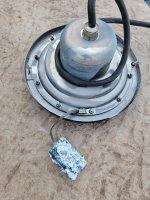In your setup, the zinc slug was the anode (-) with electrons flowing from the anode to the steel light right and house which served as the cathode (+). Oxidation, or an increase in the positive charge of the Zn metal ion, occurs at the anode -
Zn0solid ----> Zn2+aq + 2 e-
In reality, zinc ions are too reactive to remain in water and so there is the formation of zinc oxides and hydroxides and that is all the crusty, crystalline junk you found in the light niche and on the surface of the zinc slug itself.
The stainless steel metal becomes the cathode and that is where reduction happens, that is, the electrons from the zinc metal travel to the iron and charge it up. The problem with steel is that it is a super-complicated alloy surface and stainless steel has an exceptionally thin but rigidly adherent chrome oxide passivation layer. This is what protects stainless steel from rusting (and why an anode is not necessary). So the stainless steel body kind of acts like a giant capacitor that presents a charge to the water solution around it. When it does that, the extra electrons will actually combine with dissolved metals in the water and those metals will plate out onto the surface of the steel. In fact, the galvanic corrosion process and the electrochemical plating process for coating metals are one and the same. So basically all of that "black" coloring on the steel retaining ring was just plated out metals ... probably a very thin layer of iron oxide or some mixed iron/copper oxide. Plated metals don't adhere to stainless steel cathodes very well and are easily scrubbed off ... this is why in the metal plating industry, steel racks, hooks and pins are used to fastened oddly shaped objects in a plating bath. The object you want to coat will get a nice adherent coating and all the mounting hardware to hold it in place will be coated as well but easily reused by simply cleaning off all excess metal. When I did gold plating on contact parts, the "cathode basket" was made out of stainless steel so that the excess gold could be stripped off and saved. We would send the spent gold coated hardware back to the chemical supplier for a discount on gold cyanide salts.




